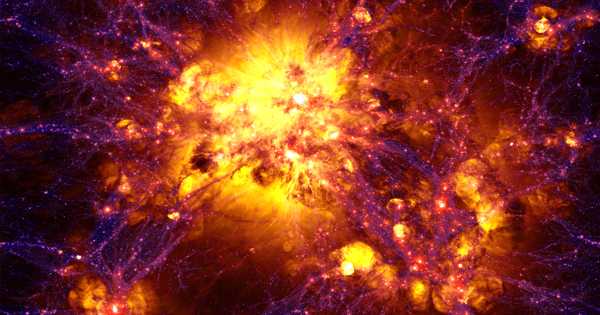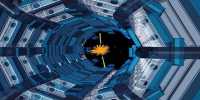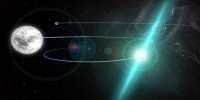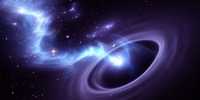The mechanical motion and electronic properties of a tiny blue crystal have been linked together, or “entangled,” by physicists at the National Institute of Standards and Technology (NIST), giving it a quantum edge in measuring electric fields with record sensitivity that may improve understanding of the universe.
The quantum sensor is made up of 150 beryllium ions (electrically charged atoms) that self-arrange into a flat 2D crystal 200 millionths of a meter in diameter when confined in a magnetic field. Quantum sensors like this one have the potential to detect signals from dark matter, a mysterious substance that, according to some theories, is made up of subatomic particles that interact with normal matter via a weak electromagnetic field. The presence of dark matter may cause the crystal to wiggle in distinct ways, as revealed by collective changes among the crystal’s ions in one of their electronic properties, known as spin.
Researchers can measure the vibrational excitation of the crystal (the flat plane moving up and down like the head of a drum) by monitoring changes in the collective spin. Measuring the spin indicates the degree of vibrational excitation, also known as displacement.
Physicists have linked together, or ‘entangled,’ the mechanical motion and electronic properties of a tiny blue crystal, giving it a quantum edge in measuring electric fields with record sensitivity that may enhance understanding of the universe.
This sensor has more than ten times the sensitivity of any previously demonstrated atomic sensor for measuring external electric fields with the same vibration frequency as the crystal. (Technically, the sensor can measure 240 nano volts per meter in one second.) In the experiments, researchers excite and test the crystal sensor using a weak electric field. A search for the dark matter would look for such a signal.
“Ion crystals could detect certain types of dark matter, such as axions and hidden photons, that interact with normal matter via a weak electric field,” said NIST senior author John Bollinger. “The dark matter particle produces a background signal with an oscillation frequency that is proportional to its mass. Experiments using superconducting circuits to search for this type of dark matter have been ongoing for more than a decade. The motion of trapped ions provides sensitivity over a wide frequency range.”
Bollinger’s group has been working with ion crystals for over a decade. What’s novel is the use of a specific type of laser light to entangle the collective motion and spins of a large number of ions, as well as a “time-reversal” strategy to detect the results.
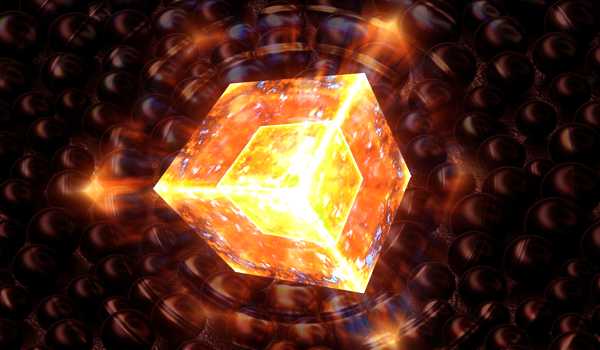
Collaboration with NIST theorist Ana Maria Rey, who works at JILA, a joint institute of NIST and the University of Colorado Boulder, aided the experiment. According to Bollinger, the theory work was critical for understanding the laboratory setup’s limits, provided a new model for understanding the experiment that is valid for large numbers of trapped ions, and demonstrated that the quantum advantage comes from entangling the spin and motion.
Entanglement, according to Rey, is beneficial in canceling the ions’ intrinsic quantum noise. It is difficult, however, to measure the entangled quantum state without destroying the information shared by spin and motion.
“To avoid this problem, John can reverse the dynamics and disentangle the spin and motion after the displacement is applied,” Rey explained. “This time reversal decouples the spin from the motion, and the collective spin now stores the displacement information, allowing us to determine the displacement very precisely when we measure the spins. This is really cool!”
Microwaves were used by the researchers to generate the desired spin values. Ions can spin up (often pictured as an arrow pointing up), spin down, or any other angle, including both at the same time, which is a special quantum state. In this experiment, the ions all had the same spin (first spin up, then horizontal), so when excited, they rotated together in a pattern resembling spinning tops.
Crossed laser beams with nearly the same frequency difference as the motion were used to entangle the collective spin with the motion. After that, the crystal was vibrated. To break the entanglement, the same lasers and microwaves were used. Researchers measured the spin level of fluorescence of the ions to determine how much the crystal moved (spin up scatters light, spin down is dark).
Increasing the number of ions to 100,000 in the future by creating 3D crystals is expected to improve sensing capability thirtyfold. Furthermore, the stability of the excited motion of the crystal could be improved, which would improve the time reversal process and the precision of the results.
“If we can improve this aspect, this experiment has the potential to become a critical resource for detecting dark matter,” Rey said. “We know that dark matter makes up 85 percent of the matter in the universe, but we don’t know what it’s made of. This experiment may one day allow us to solve this mystery.”
